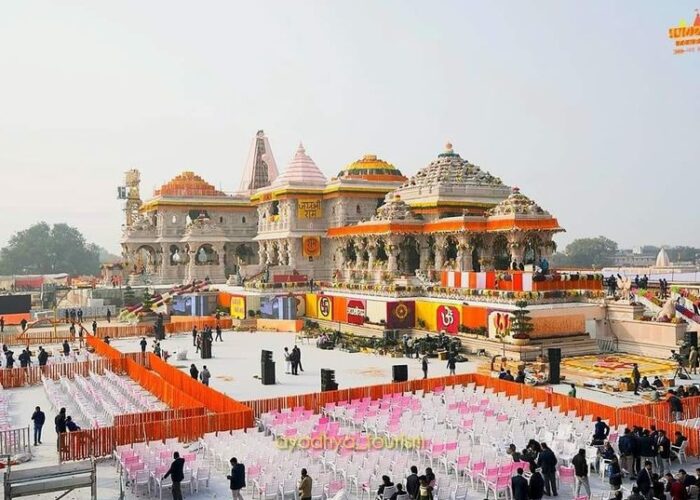Ayodhya Travel Guide: Ayodhya, one of the ancient cities of India, is included in the seven sacred puris in Hindu mythological history, along with Ayodhya, Mathura, Maya (Haridwar), Kashi, Kanchi, Avantika (Ujjayini) and Dwarka. Ayodhya has been described as the city of God in Atharva Veda and its prosperity has been compared to heaven. According to Skandapuran, the word Ayodhya is ‘A’ meaning Brahma, ‘Y’ meaning Vishnu, and ‘Dha’ meaning Rudra.
There have been many great warriors, sages, and incarnate men in Ayodhya. Lord Ram was also born here. According to Jainism, 5 Tirthankaras including Adinath were born here. Ayodhya has been ranked first among the ancient Saptapuris of India. According to Jain tradition also, out of the 24 Tirthankaras, 22 belonged to the Ikshvaku dynasty. Among these 24 Tirthankaras, Ayodhya is also the birthplace of the first Tirthankara Adinath (Rishabhdev Ji) along with four other Tirthankaras. According to Buddhist beliefs, Buddha Dev lived in Ayodhya or Saket for 16 years.

Who established Ayodhya?
Situated on the banks of river Saryu, this city was founded by Vaivaswat Manu Maharaj, son of Vivaswan (Surya) according to Ramayana. According to the history of Mathuras, Vaivaswat Manu died around 6673 BC. Kashyap was born from Brahmaji’s son Marichi. Kashyap was married to Vivaswan and Vivaswan’s son was Vaivaswat Manu.
Vaivaswat Manu had 10 sons – Ila, Ikshvaku, Kushanam, Arishta, Dhrishta, Narishyant, Karush, Mahabali, Sharyati and Prishad. In this only the Ikshvaku clan expanded more. There have been many great kings, sages, arahants and gods in the Ikshvaku clan. Later, Lord Shri Ram was born in the Ikshvaku clan. Ayodhya was ruled by people of this dynasty till the Mahabharata period.
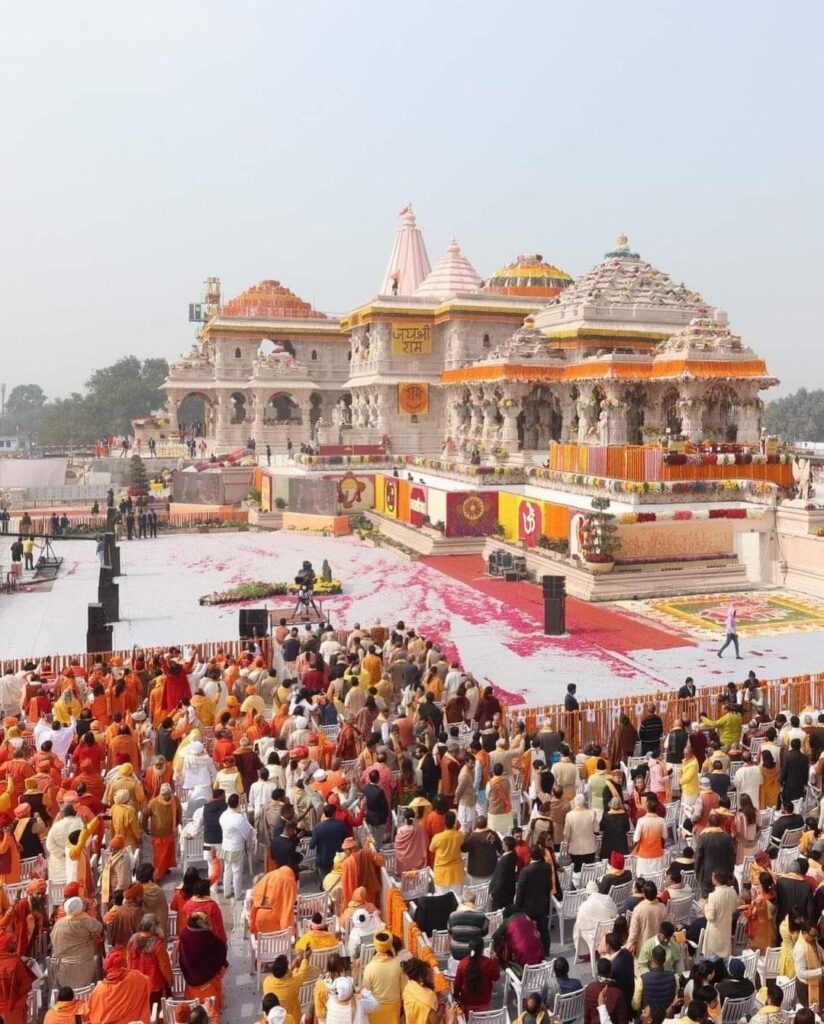
How was it established?
According to mythology, when Manu asked Brahma to build a city for himself, he took him to Lord Vishnu. Vishnuji told him about a suitable place in Saketdham. Vishnuji sent Devshilpi Vishwakarma along with Brahma and Manu to settle this city. Apart from this, he also sent Maharishi Vashishtha with him to find a suitable place for his Ramavatar. It is believed that Vashishtha selected Leelabhoomi on the banks of river Saryu, where Vishwakarma built the city. According to Skandapuran, Ayodhya is situated on the wheel of Lord Vishnu.
Who ruled Ayodhya?
In many parts of North India like Kaushal, Kapilvastu, Vaishali, and Mithila, the rulers of the Ikshvaku dynasty of Ayodhya had established their kingdoms. The origin of the history of Ayodhya and Pratisthanpur (Jhunsi) is related to Manu, the mental son of
Brahmaji. Just as the establishment of Pratisthanpur and its Chandravanshi rulers is linked to Manu’s son Ail, who was transformed into Ila by the curse of Shiva, similarly Ayodhya and its Suryavansh started from Manu’s son Ikshvaku.
How to reach Ayodhya by Ayodhya Travel Guide?
How to reach by air?
If you are thinking of going to Ayodhya by flight, now iin Ayodhya a domestic airport well conected from Delhi, Mumbai, & Chennai (till now these days). But Lucknow International Airport is the nearest airport to Ayodhya. Apart from this, one can also reach from Gorakhpur, Prayagraj and Varanasi airports.
How to reach by train?
You can catch trains to Ayodhya from different cities across the country. The distance of Ram temple from Ayodhya Junction is about six kilometers. This will be the closest you will get to see Ram Lala. Apart from this, you can also take train from Faizabad. Apart from this, Ayodhya is 130 km from Lucknow, 200 km from Varanasi, 160 km from Prayagraj, 140 km from Gorakhpur and 636 km from Delhi.
How to reach by road?
Uttar Pradesh Transport Corporation buses are available 24 hours a day, and it is very easy to reach from all places. The city is approximately 130 km. is far. 200 km from Lucknow. 160 km from Varanasi. From Prayagraj, 140 km. From Gorakhpur and about 636 km. From Delhi. Buses are frequently available from Lucknow, Delhi and Gorakhpur. Buses are also available from Varanasi, Prayagraj and other places as per their timings.

Tourist Places in Ayodhya
Hanuman Garhi
It is built in the shape of a fort and is accessible by climbing 76 steps. Ancient temples from the 10th century can be found in this pilgrimage town. There are circular fortifications at every corner and it is believed to be the place where Hanumanji lived in a cave and protected the city.
A golden statue of Hanuman ji is installed in this temple, it is considered one of the most respected places in Ayodhya.
Every day thousands of devotees visit Hanuman Garhi to worship Lord Hanuman and for protection from evil and for prosperity and happiness.
Ramkot
Ramkot is located on high ground and full of temples, it is one of the major attractions of Ayodhya. According to the Hindu calendar, the festival of Ram Navami is celebrated here in the month of Chaitra (March-April) with much splendor and pomp. At this time, pilgrims not only from all over the country but also from all over the world gather here and express their devotion towards Lord Rama. (Opening hrs Summer – 6:30 a.m. to 10:30 a.m. and 3:00 p.m. to 6:00 p.m., Winter – 7:30 a.m. to 10:30 a.m. and 2:00 p.m. to 5:00 p.m.) Until 12:00 a.m.)
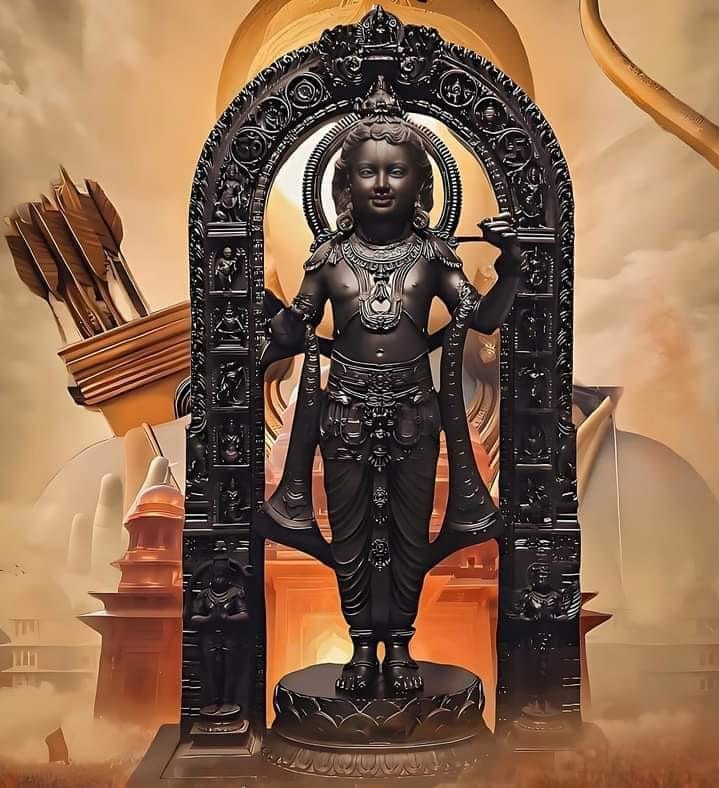
Shri Nageshwarnath Temple
Lord Nageshwar Nath ji is considered to be the main presiding deity of Ayodhya. It is believed that Kush, son of Lord Rama, had built this magnificent temple dedicated to Lord Nageshwarnath.
The Shivalinga established here is considered to be very ancient. According to folk tales, Kush was taking a bath in the Saryu River when his armlet fell into the water. After a while, a snake girl appeared and returned his armband. Both of them fell in love with each other and after that this temple was also built for them by Kush.
Being one of the most important and respected temples in Ayodhya, a large number of devotees from all over the country come here during the festival of Mahashivratri. The current temple building was constructed in 1750 AD.
Kanak Bhavan
Queen Vrishabhanu Kunwari of Tikamgarh (Madhya Pradesh) built this exquisitely decorated temple in 1891.
The main temple has an internal open space where there is a holy shrine of Ramapada. The idols of Mother Sita and Lord Rama and his three brothers are very beautiful.
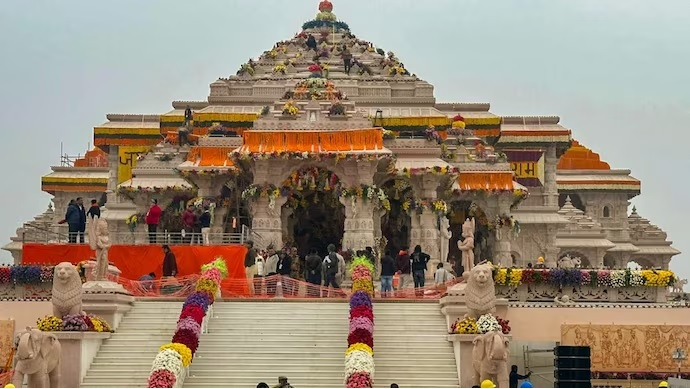
Tulsi Memorial Building
Tulsi Memorial Building is dedicated to the great saint poet Goswami Tulsi Das Ji. Regular prayer meetings, devotional conferences and religious discourses are organized here. Ayodhya Research Institute is also located in this complex which has a collection of works written by Goswami Tulsi Das Ji.
Ramlila is staged every day from 6:00 pm to 9:00 pm in the Tulsi Memorial Auditorium, which is a major attraction.
Thakur of Treta
It is also famous by the name of Black Ram Temple, it is believed that Lord Ram performed Ashwamedha Yagya in this beautiful temple. The king of Kullu (Himachal Pradesh) had built this temple about three centuries ago. Later, Queen Ahilyabai Holkar of Indore (Madhya Pradesh) got it renovated. The idols installed here are made of black stone. It is believed that these sculptures belong to the era of King Vikramaditya.

Jain temple in Ayodhya
This is not only the birthplace of Lord Ram but is also a place of great importance for Jains, it is believed that 5 Jain Tarthankaras were born here.
Every year, followers arrive here in large numbers to pay their respects to these great saints and participate in special events. There are also many Jain temples throughout the holy city, the temple of Lord Adinath near Swargadwar, the temple of Lord Anantnath near Golaghat, the temple of Lord Sumannath at Ramkot, the temple of Lord Ajitnath near Saptasagar and the temple of Lord Abhinandan Nath at Sarai are worth seeing. is.
A huge Jain temple is established in Raniganj area, in which a 21 feet high statue of the first Tirthankar Lord Adinath (Rishabhdevji) is specially installed.
Gem Mountain
It is believed that Hanuman ji was carrying a huge mountain with Sanjivani herb to Lanka for the treatment of injured Lakshman, when some part of it fell on the way. The hill formed from this, which is 65 feet high, is known as Mani Parvat.

Chhoti Devkali Temple
This temple located near Naya Ghat is related to many legends of the Hindu epic Mahabharata. According to legends, Mother Sita came to Ayodhya with the idol of Goddess Girija after her marriage with Lord Rama. It is believed that King Dasharatha built a beautiful temple and installed this idol in the sanctorum of the temple. Mother Sita used to worship here every day. Presently it is dedicated to Goddess Devkali and that is why it got this name.
Ram ki Paadi
A series of ghats have been established along the banks of river Saryu which provides a place for devotees who come here to wash away their sins. There are also lush green gardens here which are surrounded by temples. The river bank presents a picturesque view especially in the milky light of night. Devotees come to this ghat to take a dip of faith in the holy river and it is believed that just by taking a dip in this river, the sins of the devotees are washed away. Saryu river provides continuous supply of water to the ghat and it is maintained by the Irrigation Department, Government of Uttar Pradesh.

Saryu River
Saryu River, one of the major waterways of Uttar Pradesh, finds mention in ancient Hindu texts such as the Vedas and Ramayana. Literally translated as “that which is flowing”, this flow flows through Ayodhya and is believed to rejuvenate the city and wash away the impurities of this religious city.
Thousands of devotees come here on various religious occasions throughout the year to take a dip of faith in this river.
Queen Ho Memorial Park
The holy city of Ayodhya in Uttar Pradesh attracts hundreds of South Koreans every year who come here to pay their respects to the famous queen ‘Ho-Hwang Ok’. According to legend, Queen ‘Ho-Hwang Ok’, also known as Princess Suriratna, was the princess of Ayodhya before marrying King Kim Suro of the ‘Karak’ dynasty of South Korea in 48 AD and settling there. It is believed that she reached Korea by boat and became the first queen of King Suro of Geumgwan Gaya. She was 16 years old when she married and is considered the first queen of Gaya state.
Due to his memorial being situated in Ayodhya, 60 lakh people of Karak dynasty consider this city as the maternal home of Queen ‘Har-Hwang Ok’. This memorial in Ayodhya was inaugurated for the first time in the year 2001.
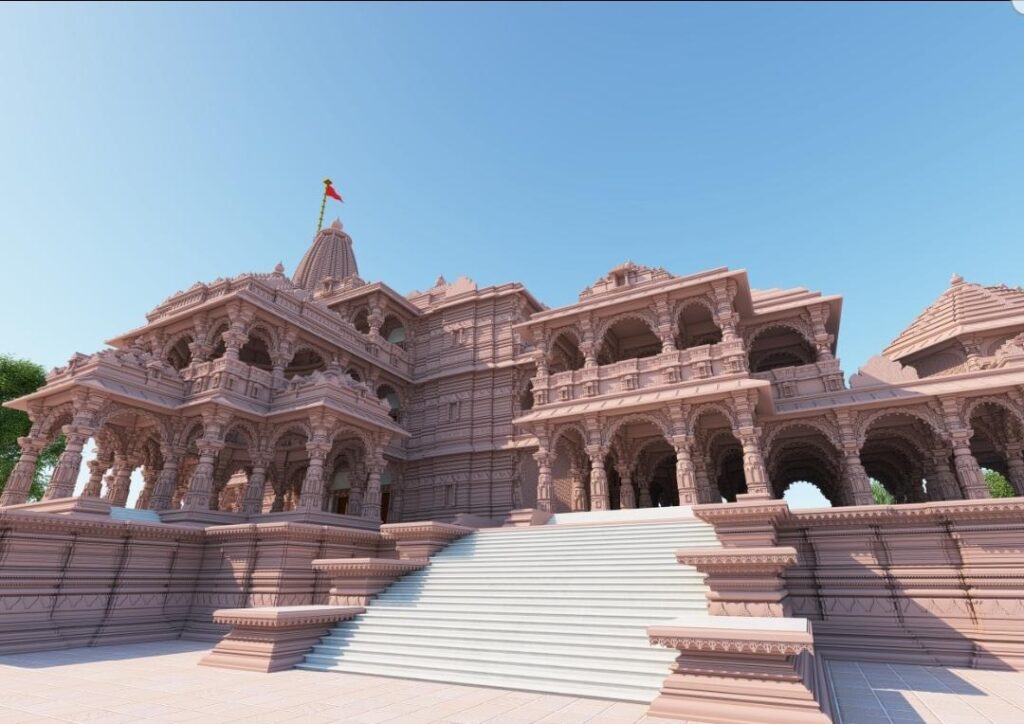
Tomb of Bahu-Begum
This is the last resting place of Begum Ummatuz Zohra Bano, who was the Begum of Nawab Shuja-ud-Daula. This tomb is an excellent example of Awadhi architecture. The entire complex is full of greenery and is now a protected site under the Archaeological Survey of India (ASI) and is maintained by the Shia Board Committee (Lucknow). Its liveliness during Muharram is worth seeing.
This is the tallest building in Ayodhya and a panoramic view of the entire city can be seen from its upper part.
Pond and Ghat
The famous ghats and ponds here are Raj Ghat, Ram Ghat, Laxman Ghat, Tulsi Ghat, Swargadwar Ghat, Janaki Ghat, Vidya Kund, Vibhishan Kund, Dant Dhawan Kund, Sita Kund etc. Other attractive places include Amovan Temple, Dashrath Mahal, Janaki Mahal, Laxman Fort, Luv-Kush Temple, Mattagyanadaji Temple, Raj Gaddi, Shri Ram Janaki Birla Temple and Valmiki Ramayana Bhavan.
Guptar Ghat
Situated on the banks of river Saryu, this is the place where Lord Ram took Jal Samadhi. Raja Darshan Singh had it built in the first phase of the 19th century. Here, Ram Janaki Temple, Purana Charan Paduka Temple, Narasimha Temple and Hanuman Temple can be seen on the ghat.

Ayodhya Travel Guide by Delighted Journey

